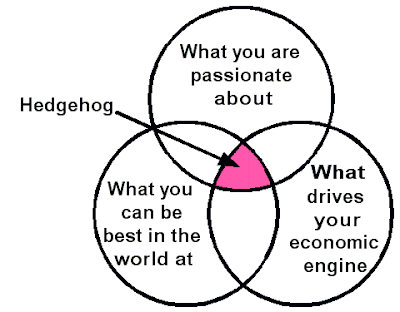- Level 5 Leadership: Leaders who are humble, but driven to do what’s best for the company.
- First Who, Then What: Get the right people on the bus, then figure out where to go. Finding the right people and trying them out in different positions.
- Confront the Brutal Facts: The Stockdale paradox – Confront the brutal truth of the situation, yet at the same time, never give up hope.
- Hedgehog Concept: Three overlapping circles: What makes you money? What could you be best in the world at? and What lights your fire?
- Culture of Discipline: Rinsing the cottage cheese.
- Technology Accelerators: Using technology to accelerate growth, within the three circles of the hedgehog concept.
- The Flywheel: The additive effect of many small initiatives; they act on each other like compound interest.
- A leader must be of great use
- Good is the enemy of great
- What separates the great from the good, the exceptional from the average.
- If all we have great businesses, we will merely have prosperous nations. They will not be great. In order to be a great nation, we must have great institutions, including schools, hospitals, and churches.
- Jim took a turn to the dark side to look at why some of the greatest enterprises in history fall from great to good to mediocre to bad to irrelevant to gone. If it can happen to them, it can happen to anyone. No company, no church, no nation, no society no individual is immune – anyone can fall.
- The mighty fall through a series of stages – organizational decline is more what you do to yourself than what happens to you.
- Leaders matter – the good to great leaders are different, they are cut from a different cloth.
- Humility is essential for great leadership.
- Packard’s Law – “No company can consistently grow revenues faster than its ability to get enough of the right people to implement that growth and still become a great company. [And] If a company consistently grows revenue faster than its ability to get enough of the right people to implement that growth, it will not simply stagnate; it will fall.”
- Jim Collins How The Mighty Fall (page 55-56)
- The number one step is to always regulate growth by the question – do we have all our key sets filled with fantastic people? If not, we must resist growth until we have them.
- Get the right people on the bus and then figure out where to drive the bus!
- Is your Team on the way up or a team on the way down?
- Preserve the core and stimulate progress.
- You must never confuse faith and facts. You must face the most brutal facts.
- Greatness is a cumulative process that requires continual discipline.
- You can be in late stage 4 and you can still come out of decline.
- You measure your success by money, you will always lose.
- What would be lost if we disappeared? What would fill the space we left?
- The signature of mediocrity is not the inability to change, it’s chronic inconsistency. – Jim Collins
- Great companies succeed because they have a reason to endure.
- Great companies will not compromise on their values and purpose; their core values are not open for compromise.
- The test of a first-rate intelligence is the ability to hold two opposed ideas in mind at the same time and still retain the ability to function.
F. Scott Fitzgerald - We need big, hairy, audacious goals.
TO DO LIST:
1. Do your diagnostics – the Good/Great Diagnostic tool. Confront the brutal facts of where you can do better.
2. Count your blessings – literally, in a spreadsheet. Don’t stop until you get to at least 100.
3. Double your questions to statements ratio. Ask the right questions.
4. How many key seats do you have on the bus? How will you get to 100% of the seats filled with fantastic people?
5. Do a “Teams on the Way Up-Teams on the Way Down” Diagnostic
6. With a team of right team assembled, create an inventory of the brutal facts.
7. Make a “Don’t Do List”
8. Define results and focus on milestones
9. Double your reach to young people by changing your practices without changing your core values
10. Set a Big Hairy Audacious Goal. Remind yourself that your work is never done.
Never capitulate, never give in!








3 comments:
kyrie shoes
coach outlet
birkin bag
supreme clothing
yeezy shoes
vans outlet
kd 11 shoes
nike foamposite
curry 6
supreme clothing
see this here Ysl replica check out the post right here best replica designer bags website link best replica bags online
here are the findings check helpful resources useful link hop over to here Click This Link
Post a Comment